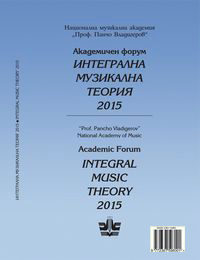Модулацията като основа на музикалната форма в контекста на учението на Хуго Риман
Modulation as a Basis of Musical Form in the Context of the Work of Hugo Riemann
Author(s): Andrey DiamandievSubject(s): Fine Arts / Performing Arts, Cultural history, Music
Published by: Издателство НМА „Проф. Панчо Владигеров”
Keywords: modulation; harmony simplified; or the theory of the tonal functions of chords; change of meaning; intermediate cadences; extended; intermediate dominants; pedal point; reflexive move;
Summary/Abstract: In the following text the author makes an analogue between the modulation theories of Hugo Riemann and Parashkev Hadjiev as representatives of two different schools of harmony, as well as their different positions concerning the fundamental connection: modulation – musical form, with the focus on Riemann’s 'Systematische Modulationslehre als Grundlage der musikalischen Formenlehre' ('Harmony Simplified or the Theory of the Tonal Functions of Chords.') According to Riemann, modulation is no more than functional interpretation (Umdeutung der Funktionen) in the meaning of a new explication, or change of functional meaning, while in Parashkev Hadjiev modulation is a transition to the new; it is fully formed and established with a cadential tonality. For Riemann the genesis of large forms is in small structures, i.e., cadences. Thus, according to Riemann, the difference between intermediate cadences and modulation is only in size but not in content. In a static tonal center as tonic, different tonalities appear only as different levels of extended harmony according to their functional meaning, in Riemann’s terminology. The author follows different harmonic phenomena in the meaning of potential or real modulation as: cadence and its different forms of extensions (for example, using intermediate dominants and pedal points), tonal jumps (Tonalitatssprunge) and modulation. The text takes into account the differences with our harmony school – for example, the so-called (Ruckgang) in Riemann, which returns us to the original tonality.
Journal: Академичен форум »Интегрална музикална теория«
- Issue Year: 2016
- Issue No: 1
- Page Range: 101-115
- Page Count: 15
- Language: Bulgarian

